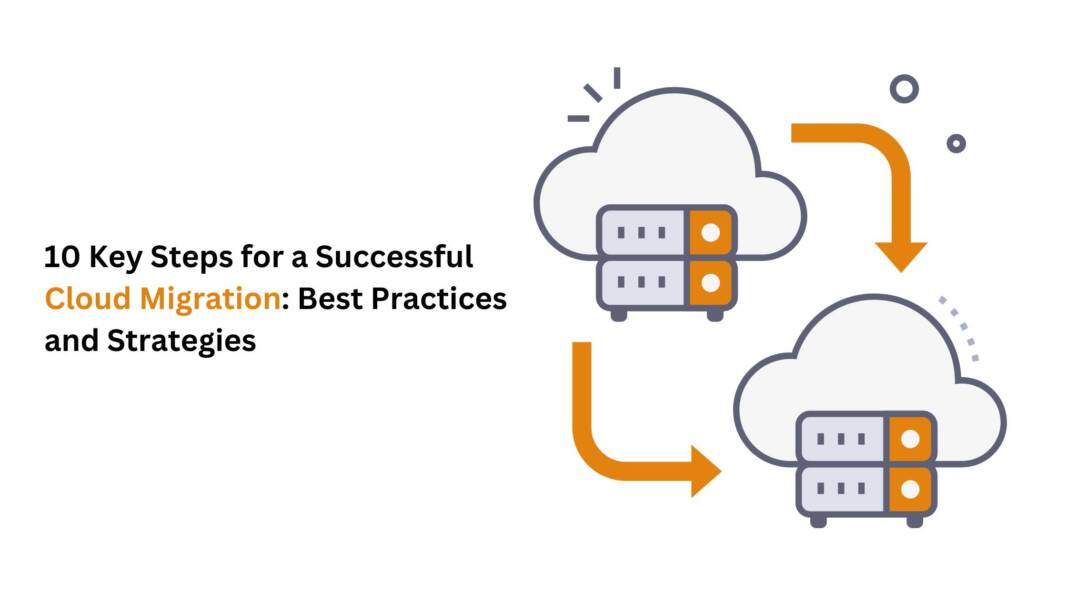A cloud migration strategy is a plan through which an organization migrates its infrastructure resources to the cloud, such as data, services, and applications. Cloud utilization has increased since the early 2000s, when businesses like Salesforce and Amazon introduced the cloud concept. The advent of the 2020 COVID-19 pandemic saw organizations report significantly more cloud usage than usual. This happened primarily due to distant working requirements and the necessity to drive innovation. According to a survey, 90% of organizations also expect cloud usage to exceed previous projections this year. But cloud migration demands extensive knowledge and patience, thus you need to hire a cloud consulting company to facilitate the entire process for you. Let’s know about the key steps for a successful cloud migration.
10 Steps for Successful Cloud Migration
Cloud migration is crucial for modern businesses as it offers many benefits including scalability, flexibility and helps in optimizng costs. Below are ten major steps for successful cloud migration:
1. Define Your Objective for Cloud Migration
This is the first and the most crucial step of your cloud migration journey. You must know what is your motivation behind cloud migration. Migrating to the cloud enables real-time efficiency and security. Knowing what your upcoming goals for your business are will help you draft a robust cloud migration strategy. The cloud migration strategy should align with your business goals and objectives. It helps you find the cloud deployment type for your business- public, private, or hybrid. Furthermore, it lets you determine the cloud service providers that meet your requirements.
2. Assessment & Priortization
Have you assessed your cloud infrastructure and prioritized the workloads? If not, you must do it before migrating to the cloud. This helps you identify the data and applications that need to be migrated in order. The factors that must be considered are your IT infrastructure’s size, application complexity, security, and compliance.
3. Utilize Pricing Tools
There is a buzz around that cloud is cheaper, but the cloud is vast and dynamic in nature. This means that costs can skyrocket at any time. The applications working fine on-premise can look like a costly affair in the cloud if not planned intelligently. To avoid such instances, businesses can utilize pricing tools. Companies offering cloud migration services utilize these calculators to determine the cost of entire planned set up. Examples for the pricing tools are- AWS pricing calculator, Google’s cloud pricing calculator etc. Furthermore, they also provide real-time advice for optimized cloud set up.
4. Keep your Disaster Recovery Plan Ready
A successful cloud migration requires a comprehensive strategy and a tried-and-tested setup. Even with the best planning and execution, backups and fail-safes must be in place to deal with unexpected downtimes. Disaster recovery plans are beneficial in such instances. Most organizations have a DRP, which needs to be regularly updated and checked. While developing the cloud migration strategy, organizations must guarantee their DRP is watertight and move ahead as needed.
5. Avoid Vendor Lock-in
Cloud migration is an ongoing and time-consuming process. It is crucial to choose the right cloud vendor for your organization. When choosing the right cloud service provider, businesses must consider the current services they offer and the roadmap they share. Are they planning to integrate new technologies in the future? If the provider fails to keep up with the latest technologies, the firm will eventually lose its competitive advantage. Some organizations mitigate this risk by utilizing numerous cloud vendors. The multi-cloud setup enables easy access to features from several vendors.
6. Train Your People
After migrating to the cloud, businesses’ ways of operating change. It varies from working in-house, especially if the company has moved from legacy systems to the cloud. A lot of automation gets involved, and businesses start scaling. Employees must be trained to operate with cloud providers. This training cannot be a one-time event due to the ongoing upgrades. As a result, the cloud migration strategy must consider the time and capital commitment required for this training.
7. Priortize Automation
Adavnced automation reduces manual intervention and reduces the chances of errors. In a cloud environment, the organization’s control is limited, with many cloud services operating as black boxes. To bridge this gap, the use of middleware tools for automation is essential. The establishment of continuous integration (CI) and continuous delivery (CD) techniques is a must to maintain control and efficiency.
8. Keep up with the Trends
The cloud is an advanced buzzword that has everything in it. Businesses must keep up with the latest trends and technologies and possible integrations with their businesses. Some companies migrate to the cloud to ensure their infrastructure is future-proof. This is because cloud providers constantly release new functionalities. It is up to the organization to stay current with new features and improve. The cloud migration strategy must include an update cycle to guarantee that the firm reaps the full benefits of the cloud.
9. Ensure Data Security & Compliance
Data security is the most crucial aspect that businesses must consider during cloud migration. The modern world operates on data. You must ensure that your data is secure during migration and adheres to all applicable legislation and standards. You should also review the security features the cloud service provider offers and adopt additional security measures if required.
10. Choose the Right Cloud Service Provider
The success of cloud migration is directly proportional to the support of cloud service provider. Thus it becomes crucial to choose the right cloud service provider. You should compare cloud service providers based on security, dependability, scalability, and cost-effectiveness. You should also assess the provider’s experience with cloud migration, similar to your organization’s, and their ability to provide technical support.
Conclusion
By adhering to the best practices mentioned above in this article, you can ensure a smooth cloud migration that minimizes disturbance to your business operations while maximizing the benefits of cloud computing. Remember to evaluate your company’s needs, select the best cloud service provider, create a robust migration plan, test correctly, and keep security and compliance in mind throughout the process. You can also engage an experienced company that provides cloud migration services to help your business grow.

Ingrid Maldine is a business writer, editor and management consultant with extensive experience writing and consulting for both start-ups and long established companies. She has ten years management and leadership experience gained at BSkyB in London and Viva Travel Guides in Quito, Ecuador, giving her a depth of insight into innovation in international business. With an MBA from the University of Hull and many years of experience running her own business consultancy, Ingrid’s background allows her to connect with a diverse range of clients, including cutting edge technology and web-based start-ups but also multinationals in need of assistance. Ingrid has played a defining role in shaping organizational strategy for a wide range of different organizations, including for-profit, NGOs and charities. Ingrid has also served on the Board of Directors for the South American Explorers Club in Quito, Ecuador.








